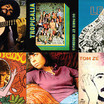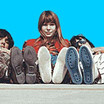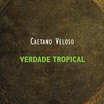Eubioticamente atraídos

topos and topicalities
Foreign views
TOPOS AND TOPICALITIES
The Tropes of Tropicália and Tropicalismo
Charles A. Perrone – University of Florida
Publicado originalmente em 1999 para Studies in Latin American Popular Culture
Nego-me a folclorizar o meu subdesenvolvimento para compensar as dificuldades técnicas
Caetano Veloso, 1967
…topos de conciliação dos contrários, da inconciliação dos mesmos…
Waly Salomão, 1987
As the twentieth century closes, multiform observations of the millenium occur worldwide. Brazil, for its part, celebrates the five-hundredth anniversary of “encounter,” the New World “discovery” of Pedr’Alvares Cabral. Reflections on state formation, historical legacies, and national identity abound in the country. An expected exercise in stock-taking is to retrospect on the trajectory of culture in Brazil, from primordial colonial times to the current era of globalization with its attendant anxieties. Given the public imperatives of modernismo and the sweeping changes that resulted from the revitalizations of the 1920-30s, that monument remains the primary point of reference for the arts. As for mid-twentieth century culture, three phenomena are essential to consider both for their inherent qualities and for their insertion in transnational spheres of action, evaluation, and recognition: concrete poetry, in the restricted but intellectually prestigious area of poetry; soccer (1958, 1962, 1970 world championships), in an area of all but universal interest, albeit of limited import in the US; and Bossa Nova, in the domain of considerable consumption that is popular music, with significant extension, in this case, into the US as well.
A decade after the emergence of concrete poetry, Pelé, and Bossa Nova, came the flourishing known as Tropicália or tropicalismo, a watershed in the contemporary Brazilian arts that has been compared in importance to the 1922 Semana de Arte Moderna that launched modernismo. The thirtieth anniversary of the Tropicalist adventure was commemorated in 1998 with a series of events and musings on the brief but extremely influential movement, which, like most other originally contestatory artistic projects that prove successful, has been incorporated into the mainstream. Renewed discussions about Tropicália were given strong impetus with the publication of Verdade tropical (1997), the multifarious memoirs of singer-songwriter Caetano Veloso, nearly unanimously regarded as the key voice of tropicalismo. Thematic public festivities (carnaval in Salvador, 1998) and academic events on three continents paid homage to and explored the ramifications of the late-sixties’ occurrences in popular music, cinema, et al. that constituted tropicalismo. Critical landmarks of related criticism (e.g. Augusto de Campos, Roberto Schwarz, Silviano Santiago, Gilberto Vasconcellos, Celso Favaretto) are revisited in new deliberations on the legend and canonization of Caetano Veloso, the institutionalization of Tropicalist moments, or their reflections in current trends, such as the mangue movement in Recife. The metaphorical discourse and hybrid music of mangue beat, in particular, are reminiscent of the experiments in song and performance at the core of Tropicália. That Northeastern production is another variant of the contemporary Brazilian popular music (MPB) that once again is on stage and at issue abroad in the late 1990s, as seen below in specific relation to Veloso and company.
How has tropicalismo endured and become a fundamental frame of reference in contemporary Brazilian cultural affairs? Why did this conflagration in the arts have such an intense impact at its time? Why did theatrical and musical episodes take on such inflated meanings in the late 1960s? These are questions that have motivated and continue to elicit criticism of Tropicalist phenomena, especially at this temporal juncture. The present study first broaches the question of delimitation of tropicalismo / Tropicália, its characterization in wider or more narrow terms, and proceeds to assess its varied levels of operation, scope of attack, aims and achievements. One of the most commonly invoked frames of reference vis-à-vis the articulation of tropicalismo is antropofagia, the cultural cannibalism devised by Modernist Oswald de Andrade. Those connections and ties to the concrete poets are queried here in relation to the interrelated questions of national identity and aesthetic worth. The idea of “poetry for export,” beyond pertinence to an assertive sort of nationalism in tropicalismo in the 1960s, finally, provides a bridge to the reception of Tropicália abroad in the 1990s.
Terms, Trends, Turns
The twin terms Tropicália and tropicalismo, totally interchangeable for some users, have several denotations and connotations. Their nominal, disciplinary, and temporal boundaries do not comprise epistemological or ideological problems, but declarations or clarifications of range and intent are, in pragmatic terms, instrumental for referencings and determinations of position. As a generalized tendency or attitude, the Tropicalist enterprise involved, to widely varying degrees, visual arts, popular music, theatre, film, and literature. The first mention is given because the name “Tropicália,” which Veloso adopted for own his visionary platform song, in fact came from an installation (1967) at the Museu de Arte Moderna by Hélio Oiticica, a singular artist who demonstrates affinities with efforts to come in other fields. The self-affirmative centrality and unique coalescence of popular music in tropicalismo can hardly be questioned, with at least one respected scholar of cultural affairs taking the position that extension of the movement to other areas is not justified. The role of theatre is indeed rather confined, essentially to José Celso Martinez Correia’s version of Oswald de Andrade’s O rei da vela. This staging did have a widely cited impact on Veloso and has been analyzed usefully in terms of the trend. The vincula with literature are also limited: journalists and columnists (including Nelson Mota and poet-lyricist Torquate Neto) speculated about the nascent movement, a subsequent subcurrent in poetry was described, and some prose fiction was studied as a Tropicalist voice. In film, tropicalismo is a significant presence. Glauber Rocha’s epic Terra em transe (Land in Anguish) exerted influence on both the director of O Rei da Vela and Rocha’s aesthetic cohort Veloso. Randal Johnson has analysed films, notably the unusual box-office success Macunaíma (1969), within a “third tropicalist stage of Cinema Novo” (xx), while Ismail Xavier and Sampaio have examined the plane of cinema for special issues on tropicalismo. Historically, the multi-disciplinary approach has been encouraged by the fact that the foundational (and most widely cited) critical text, Schwarz, indeed considers drama and film. Como era gostoso meu francês (How Tasty Was My Little Frenchman) (Nelson Pereira dos Santos, 1971), with links to tropicalismo via antropofagia, appeared after the central phase of the movement on which Schwarz and others concentrate.
If the terms Tropicália /tropicalismo are most commonly associated with Veloso and Gilberto Gil et al., and if it is generally agreed that popular music is the principal site of this cultural manifestation, the operative limits of Tropicalist MPB, can vary from a little more than one year (late 1967 through 1968) to half a decade (1967-1972). The relevant series of musical presentations and recordings began with the third Festival da MPB of TV Record (October 1967). By the time the suffocating AI-5 (December 1968) began to be implemented, the ephemeral experimental entertainment endeavor had already been declared defunct (“O tropicalismo está morto” sign on TV Tupi, November 1968). The LPs produced by Caetano Veloso and Gilberto Gil before their exile (mid-1969) continue in the style of their initial Tropicalist recordings, authorizing an extension of the movement in song. Favaretto and other critics analyse a repertory that encompasses works as late as Veloso’s remarkable Araça Azul (1972), by which time the movement was definitively historicized. Such recordings are profitably deconstructed, if not necessarily as part of tropicalismo, in relation to the structures of thought that constituted the movement. Whenever immediacy is in question, nevertheless, the most relevant frame is 1968, a year marked by anti-establishment and countercultural activities on a global level.
Veloso and Gil preferred the name Tropicália to tropicalismo because the former was more distinctive and did not present their project as just another -ismo in a series of artistic proposals. This logic follows that of the Noigandres group of São Paulo in the 1950s, who preferred the poesia concreta over concretismo and attempted to be known as poetas concretos not concretistas. Though the program of concrete poetry ended and the poets went on to write in substantially different styles, uncareful usage persists in encompassing the later work of the Noigandres group within the scope of the term poesia concreta. Similarly, the name tropicalismo became common currency despite the artists’ wishes, and some confusion may arise when post-1968 (or post-1972) production by Gil, Veloso or others is called tropicalista. To the extent that the movement as calculated intervention, utopian activity, or circumscribed action, is in question, terminology can be determinant. In what follows, preference will be given to the term tropicalismo to refer to the sum of multidisciplinary phenomena in a wider time span, while Tropicália will be employed largely with respect to the “heroic phase” (late 67-early 69) in popular music.
Goals and Roles
Tropicalismo enacted a consciousness of disquiet and a will to explore, putting in peril accepted artistic values, both those of conventional circles and those of the oppositional “ensaio geral de socialização da cultura” based on the national-popular model. It effected a critical revision of Brazilian culture and put forward new paradigms of plurality, permitting diversified links with folklore and industrial vanguard poetics alike. A creative “provincial” genius (the main players coming from Bahia) was shocked and activated, as it were, by modern urban experiences of technology and by a dictatorship with technocratic pretensions. In an open-ended effort to revitalize Brazilian arts, tropicalismo built a neo-anthropophagic strategy of contraposition and appropriation. Schwarz first reasoned that the appeal to contrast and the focus on contradictions in national society, the off-setting of the archaic and the modern, constitued allegory. He further saw the ironies of Left artistic hegemony in the midst of right-wing political domination. Favaretto synthesizes effectively the effect of tropicalismo: “expôs as polarizações e impasses a que tinham chegado as discussões culturais, estéticas, e políticas da arte nos anos 60.” The new popular music of Veloso and Gil, above all, was “uma prática desconstrutora e descentralizante operada pelos efeitos críticos derivados da mistura de elementos conflitantes” (“Rastros” 31). This practice was micro- and macro-; such admixtures could be realized in a frame or a final cut, in print or on stage, in the same song, in sound or word or combinations thereof, or in a repertory for performance and/or recording of a provocative syncretic view of Brazil.
Tropicalismo, especially Tropicália, was an opera aperta, an invitation to reflection. It always questioned and sometimes broke down common binaries, dichotomies of value, divisions that oriented mid-sixties’ debates , Manichean set-ups related to the production and consumption of the arts : old/new, youth/adult, foreign/national, developed/underdeveloped, sul maravilha/norte atrasado, committed /alienated, religion/cult, lyric (poetry)/lyrics (song text), good taste/kitsch (cafonice), and high/low or erudito/popular (de massas).
Hierarchies and Bridges
In the era of postmodernism, cultural studies, multiculturalism, democratization, globalization, and other aspirations, there has been a major diminishing of the centuries-old urge in Western aesthetics and criticism toward hierarchization of forms, artistic practices, and artists. If for some two of the most common qualifying spatializations (center/periphery, high/low) have become (at least nominally) a non-issue or extremely less pertinent, there are persistent engrained prejudices that affect production and reception of the spectrum of arts. Discriminatory notions of social worth or appropriateness of study of given topics in Brazil continue beyond necessary recognition of objective differentiated complexifications and relational understanding of different manifestations of given expressive practices.
Into the 1960s, class bias and distinctions between fields were, in effect, the inherited norm. Film (a sétima arte) was largely legitimized alongside the fine arts, art music, literature, theatre with their associated cultural capitals. Popular music achieved a new status, a prestige among the arts, in the turbulent Brazilian sixties. A process was set in motion in the 1950s by poet-diplomat Vinícius de Morais, when he turned his talents toward songwriting. The sophistication of Bossa Nova could not fail to become evident to gatekeepers of cultural recognition. The MPB generation of Chico Buarque et al., in turn, attained remarkable levels for so-called “popular” song. In a contemporaneous critique, for instance, art-music composer Gilberto Mendes illustrates with “Ponteio” (Edu Lobo-Capinan, 1967): “ tem todo o cuidado de fatura e acabamento de uma música erudita nacionalista, com a grande vantagem de ser popular, realizado, autêntico.” With considerable historical perspective, Ulhoa (172) has underscored that in general “MPB aesthetics emulate the Western art music canon, which means that MPB is considered art or erudite.” At the end of the decade, Augusto de Campos extrapolated on data in song to proclaim: “Desde João Gilberto e Tom Jobim, a música popular deixou de ser um dado meramente retrospectivo, ou mais ou menos folclórico, para se constituir num fato novo, vivo, ativo, da cultura brasileira, participando da evolução da poesia, das artes visuais, da arquitetura, das artes ditas eruditas, em suma.”
The erudite in Tropicália emerges both from its attention to textuality and from an engagement with unconventioanl art-music figures– Julio Medaglia, Damiano Cozzela, and, above all, Rogério Duprat– who applied avant-garde ideas to pop arrangements. Innovative Tropicalist implementations concluded the evolution of urban popular music beyond the stage of conventionally conceived “popular.” MPB repertories, though consumed by many via mass media, were, by various means, nuanced, intellectualized, and complex. The musical ideations of Tropicália, in particular, burst the sense of pop as irretrievably illiberal, for the artists infused substantial literary material into song, often in parodic or satirical modes, and exercised significant new kinds of plurissignification in musical poetics and some non-discursive approaches. This fulfillment, in the words of Favaretto (“Canção” 21) “. . . levou a atividade musical a assumir posição semelhante, em dignidade artística e prática cultural, daquelas que vinham ocorrendo acaloradamente no teatro, no cinema, na literatura e nas artes plásticas… Realizou no Brasil a definitiva autonomia da canção, estabelecendo-a como um objeto enfim reconhecível como verdadeiramente artístico.”
In assessing the impact of Tropicália, Liv Sovik compared changes in Anglo-American perceptions of popular music after the Beatles, especially with the pop and classical mixes of Sgt. Pepper’s Lonely Hearts Club Band, with the realizations of Veloso and the resorceful rock trio Os Mutantes: “Beatles– sem tradição para essa mistura– conseguiram dignificar a música popular de massas sem borrar as fronteiras, enquanto a Tropicália conseguiu estabelecer a hibridação erudito/massivo, escandalosa na época, apoiada na hibridação erudito/popular já existente no Brasil.” For Sovik, this high/low breakdown figures into an instigating interpretation of the Tropicalist adventure as post-modern.
What has moved many other analysts of MPB and Tropicália since the late sixties is not so much the desire to pay equal attention to high and low elements, nor the incorporation by high culure (literature, visual arts, concert music) of mass information, but rather how this Brazilian musical branch of supposedly “low” or “popular” culture operated in ways customarily thought of with regard to the former. Décio Pignatari had fancied concrete poetry as an objeto útil, as an intense form of poetic production that could nevertheless be appreciated, even if intuitively, much the same as a concise advertisement. To express the idea of art, especially vanguard art, apt for significant consumption, he merged produção and consumo to coin the term prodossumo. The songs of Veloso and other Tropicalists, for Pignatari and Augusto de Campos, marked a parallel: they were mass-media ready and steady but informed by sound aspects and historical, poetic, and political information that placed them on another plane of aesthetic production altogether.
There is indeed a curious co-existence in Tropicália of a mass-culture profile (complete with culture-industry support , media hype, encouragement of fad and fashion) and a discourse often of “literary quality”or on a par with “high arts.” Although this endeavor, an artful anomaly of appearance and survival in the entertainment industry, constantly relativized its own self-promotion, it never failed to have the immediacy of pop and an in mediacy of radio/TV, and the press. Gil horrified some of his idealistic MPB colleagues, in the days when future Tropicalist ideas were first being imagined, when he insisted that they must accept music as merchandise and the inevitable commercial reality of their trade. The composition and performance of that awareness proved to be one of the prime distinguishing traits of Tropicália, its “maior acerto” in the estimation of one analyst (Teixeira). Veloso even relates this aspect to a class-based sense of progress: “Uma das marcas da Tropicália . . . foi justamente a ampliação do mercado pela prática da convivência na diversidade, alcançada com o desmantelamento da ordem dos nichos e com o desrespeito às demarcações de classe e de graus de educação. . . saudável destruição de hierarquias” (Verdade tropical 281). In aspiring to make a product with artistic consciousness that could make novel contributions, to song and to a more ambitious discourse of national amplitude, but also embody market-savvy and a ready-to-use quality appreciable by common consumers, Tropicália assumed an “erudite” pose that could turn counterproductively “pretentious,” which was problematic for the widespread consumption of Tropicalist material, with its built-in contradictions.
Resolutions were available in such polyvalent compositions as “Baby” (Veloso, 1968), which has subtle Bossa Nova tones in a pop enclosure and which, while seemingly entrenched in the repetitive paradigm of adolescent courtship at a “paralitery” level, embodies, if you will, an “epistemological cut” and wry sociocultural commentary. Here and elsewhere, twists with provocative intent mark a difference in notions of bad taste and cafona, which are productively relativized. Tropicália can skirt potential for kitsch by flagging it and putting it up for contemplation. Kitsch is thought of as a sort of easy version of an artistic product that was once in the vanguard and now deceives anxious consumers, or as a diluting of original culturemes, a reduction of something superior, an anachronic banalization of an established model. In tropicalismo, acceptance, adoptions, insertions into odd positions, and playful rehabilitations of such items as the “vulgar” icon of Carmen Miranda, the melodrama of singer Vicente Celestino, or the bombastic figure of television host Chacrinha, question their very characterizations as such, and surpass or reconfigure the high/low parameters of taste.
Band-width: the Semi-Millennial Scope of Tropicalismo
An entry on “rock lyric” in the Princeton Encyclopedia of Poetry and Poetics affirms ways in which Anglo-American song texts displayed poeticity, including //intertextuality and a general broadening of thematic reach.// CHECK. Beyond their own frequent employment of poetic devices, the songs of Tropicália were notoriously “broad” in their citations and range of reference. They covered the entire of span of Brazilian history and literature, and they projected beyond. The recording of “Tropicália,” as many have noted, begins with an impromptu but extremely relevant declamation parodying “A Carta de Pero Vaz Caminha” (1500). In a notorious performance of “É Proibido Proibir,” in turn, Veloso recited excerpts of the Sebastianist (millenial) Mensagem by Fernando Pessoa. At the other end of the diacronic arc, Tom Zé’s entry into the fourth Festival da MPB (1968) was the space-age song “2001,” a moda-de-viola with a liberational text. Cinematic moments of tropicalismo activate a similar range. Como era gostoso meu francês, set in the early decades of the colony, connects to popular music via anthropophagic strategies of anti-regime intent. The futuristic Brasil ano 2000, directed by Walter Lima Jr. with sound track by Gilberto Gil, is a deliberately Tropicalist film, so conceived during the late sixties. It is hardly coincidental that the back jacket of the key creative work, the concept album Tropicália ou panis et circensis (May 1968), is structured as an experimental film script with references as disparate as the Latin foundations of Luso-Brazilian civilization, and the Noigandres anthology of concrete poetry.
In view of the itinerary of tropicalismo, Haroldo de Campos himself characterized it as “museu crítico do trópico.” For his part, participant poet-lyricist José Carlos Capinan (59) used the phrase “metralhadora giratória da Tropicália” to give an idea of the expanse of targets and the intensity of attack. Song texts of his such as “Soy loco por ti América” and “Miserere nobis” stand alongside others by Torquato Neto to constitute an inventory of “relíquias do Brasil” to be uncovered and examined by the Tropicalist gaze. The quintessential song in this regard is “Geléia geral” (Gil-Neto), whose multifarious lyric tends toward juxtapositions and blends (esp. the refrain “bumba-iê-iê-boi”). Concrete and symbolic items in the overloaded text include the flag, the tropical morning, Bahian baroque, the indispensable mulata, parodic allusions to the Romantic commonplace of Gonçalves Dias, and citations in a nod to Oswald de Andrade. In the wake of this song, Dunn concludes that “the Tropicalist allegory of Brazilian historical contradictions constitutes a site of convergence of irony and hybridity. In this sense, the ‘relics of Brazil’ from a patrimonial past and an authoritarian present were not only ‘de-territorialized’–they were also dug up from the “ruins of history” and displayed in the public square.” The results of such a Benjaminian excavation embody an uncommon intentionality in a space of contemplation that is not restricted to rural roots or urban newness, nor to national circumscriptions or a transnational cosmopolitanism. Relics are representative things, cultural items, tendencies, and behaviors (cf. the attack on middle-class complacency in “Panis et circenses” [Gil-Veloso]), which are both valued and devalued by the Tropicalist operation. Its long-range implications reverberate in the move to display, which is an essential gesture that precedes a pensive dismanteling. The wide-angled and long-shadowed projection of tropicalismo enhances its effects of multiplicity; it manifests a historical desire, to remember, reflect, and look forward. This wish links tropicalismo to concretism and Oswald.
ACT up: Antropofagia, Concretismo, Tropicalismo
There are a series of situational and textual links between Veloso, other Tropicalists, and Oswald, both his Modernist heritage and his actual repertory. The ebullience in sixties’ culture has been called a “retomada oswaldiana” (N. Ferreira), and the link to that vanguard name of modernismo is truly significant to comprehend Tropicália and kin. Their works are often reminiscent of the pride, deboche, contrastive style, or structure of Oswald’s first manifesto and books of telegraphic verse. Poesia Pau-Brasil is best read, for instance, not as a standard collection of poems but rather as a sequence, and the Tropicália collective LP is a concept album with a succession of interconnected compositions without breaks between tracks. In terms of attitudes and consequences, it is useful to apply to tropicalismo Benedito Nunes’ tripartite interpretation of the program figured in Oswald’s second manifesto:
Como símbolo da devoração, a Antropofagia é a um tempo metáfora, diagnóstico e terapêutica: metáfora orgânica, inspirada na cerimônia guerreira da imolação pelos tupis do inimigo valente apresado em combate, englobando tudo quanto deveríamos repudiar, assimiliar e superar para a conquista de nossa autonomia intelectual; diagnóstico da sociedade brasileira como sociedade traumatizada pela repressão colonizadora que lhe condicionou o crescimento. . . e terapêutica . . . contra os mecanismos sociais e políticos, os hábitos intelectuais, as manifestações literárias e artísticas. . . sob forma de ataque verbal, pela sátira e pela crítica, a terapêutica empregaria o mesmo instinto antropofágico outrora recalcado, então liberado numa catarse imaginária do espírito nacional. (15-16)
Tropicalismo, a creative endeavor with no essay per se, has no claim to make to the overall intellectual purview of Oswald’s anthropophagy, but the vehement musicalizations of key ideas do indeed resonate as part of an encompassing cultural complex, both immediate (sixties) and larger scale (twentieth century). The mere adoption of electric guitars and Anglo-American musical icons, Veloso et al. must recognize, does not constitute antropofagia; conceptualization, conscious re-elaboration, and contextualization are required. Ramifications of applications are personal, generational, professional, interdisciplinary, political:
A idéia do canibalismo cultural servia-nos, aos tropicalistas, como uma luva. Estávamos `comendo’ os Beatles e Jimi Hendrix. Nossas argumentações contra a atitude defensiva dos nacionalistas encontravam aqui uma formulação sucinta e exaustiva. Claro que passamos a aplicá-la com largueza e intensidade, mas não sem cuidado, e eu procurei, a cada passo, repensar os termos em que a adotamos. Procurei também – e procuro agora – relê-la nos textos originais, tendo em mente as obras que ela foi concebida para defender, no contexto em que tal poesia e tal poética surgiram. Nunca perdemos de vista, nem eu nem Gil, as diferenças entre a experiência modernista dos anos 20 e nossos embates televisivos e fonomecânicos dos anos 60. E, se Gil, com o passar dos anos, se retraiu na constatação de que as implicações `maiores’ do movimento – e com isso Gil quer dizer suas correlações com o que se deu em teatro, cinema, literatura e artes plásticas – foram talvez fruto de uma superintelectualização, eu próprio desconfiei sempre do simplismo com que a idéia de antropofagia, por nós popularizada, tendeu a ser invocada.” (Verdade tropical 247-248)
Tropicália clearly involved devourment of aesthetic information from abroad and from outside the normal spheres of popular music in an effort to establish a new kind of autonomy. Such appropriation was linked to a perception of second-generation Bossa Nova nationalists as unnecessarily xenophobic and as, in effect, traumatized by a condition of underdevelopment, likely exacerbated by the repression of military rule. With regard to the First World, Tropicalist artistry was proactive and instrumentalized a sense of cleansing, combatting notions of shame or relational disadvantage. The movement critqued, Veloso says in retrospect, “a nationalism that seemed naive and defensive;” he and his colleagues sought to act up, to act on a “critical attitude from a cultural perspective, an aggressive attitude, not a passive and defensive nationalism.” On numerous occasions, Veloso has referred to the futility of self-perception as peripheral, as mere victims of imperialism and cultural penetration. “We assumed an immediate posture of ‘being-in-the-world’– we rejected the role of a Third World country living in the shadow of more developed countries,” he continues “We didn’t feel humilliated by the presence of cultural influences from richer countries. . . intellectually or artistically inferior or offended.” Through Oswald and others means, the youthful Veloso and company hoped to invigorate a self-esteem that could be profitably extended to others. They sought empowerment in conjunction with an artistic maturity for themselves and for the milieu in which they operated. Their pursuit of that which could further modernize their field– the Bossa Nova of João Gilberto was a gianst step forward– privileged a transregional and transnational space of operation. The historical desire they manifested came in the same basic spirit as Oswald and concrete poetry, with implications considerably wider than a movie screen or festival stage.
Since independence and romanticism, Latin American nations have shared a conception of literature as a tool to prove worth, to raise consciousness, to inculcate loyalties, to construct societies and nations. In the case of Brazil, Antonio Candido calls this literary mission a tradição empenhada. This motivated task has largely implied cultivation of what is indigenous, natural, or endemic to the Americas, as in a central current of poetry of modernismo and in romance de trinta, the regionalist neo-realist fiction of the 1930s. Candido pondered originality based on so-called native content in “Literature and Underdevelopment.” An axial point therein is that “the most sincere nativism risks becoming an ideological manifestation of the same cultural colonialism that its practitioners would reject on the plane of clear reason, and that displays a situation of underdevelopment and consequent dependency” (135). At the turn of the decade of the 1970s, Candido continues, the question of nativeness had taken on new nuances, and “the utopias of isolationist originality no longer survive as a patriotic attitude” (132). He found it simply illusory, moreover, to speak of suppressing contacts from Europe. In comments also quite relevant to sixties’ debates in popular music or film, Candido further affirmed that one could face the question of cultural influences, with calm and without paradox, while still being against the tragedies of underdevelopment and for fundamental social change. Candido turns to the example of Brazilian concretism, especially for the way it operates “a re-definition of the national past” (134). With their critical emphasis on “invention” in Oswald and other radical makers, in conjunction with neoteric creative amalgams and select theoretical bases, concretism indeed became an inexorable point of reference not just for Brazilian poetry but for intellectual expressive culture in general.
A concern with national fortification associated with modernismo carried over to concretism in quite different guises. Concrete poetry’s defenses against charges of alienation appealed to Oswald’s Pau-Brasil primitivism, which sought a “native originality” in the fabrication of a modern “poetry of export” (quality level if not literally) to serve as a model of flow-reversal, and to his antropofagia, which proposed critical assimilation of foreign information and re-elaboration in national terms (add continuation form Nossos Classicos). Underscoring textual technology and industrial environment, the concrete poets put distance between themselves and the inspirational Oswald, with his Amerindian and natural-resource metaphors. Yet they most effectively re-cannibalized national and international poetics, taking the lead in their field of vanguard endeavor, indeed turning around the direction of the flow of information, and becoming a success abroad. Hardly preoccupied with distinguishing autochtonous working materials, the Noigandres group developed new senses of “export quality” and technical betterment, pointedly modern realizations of national achievement. Creating an option to mid-century aestheticism (formalist, neo-Parnassian verse) and to ethnically-driven orientations in the arts, concretism elaborated a countermodel of lyric that merged local and global sources in novel textual corpora as well as in sets of evolving theories, thus setting new parameters for the discussion of culture in a period highly concerned with issues of colonialism and under/development.
Also putting autochtonous authenticity in relative perspective, tropicalismo, like antropofagia and poesia concreta, elaborated experimental and iconoclastic countermodels, extreme positions vis-a-vis conventional lyrical expression, confrontation of establishment values, and reaction to cultural imperialism. Common questions of vanguardism and self-conceptualization ultimately concern affirmative re-definitions and reconfiguring a field of endeavor, in image and idea, with implications for the nation at large. Noting the persistence of debates about the vanguard in Brazil in the 1980s, Holanda found the clearest effect of the continuing discussion to be the inevitable return of the theme of national identity. The major ruptures throughout the history of the Brazilian arts occur at those moments when the relationship between the metropolis and the colony is questioned in radical fashion in a search for cultural independence. A movement can be thought of as “foundational,” in this account, when it up-dates the tension between Brazilian cultural identity and modernizing impulses through the prism of alterity. That happened with antropofagia and with concrete poetry, and with the eclectic movement of tropicalismo. (Maybe quote the part?)
Concretism set itself apart creatively with its structural strangeness and, if you will, “otherness of factitiousness,” while in terms of poetic politics, it posed the problem of identity vis-à-vis nationalism in a different light. To use a metaphor of illumination, one might say industrial light instead of the natural light preferred by most Modernists and by engagé poets and music-makers in the 1950s-1960s. With its front-line integration into an international circuit and with its proactive emphasis on a modernizing exploitation of intellectual and technical resources regardless of origin, concretism helped reconfigure the nation in cultural terms in a positive fashion. With its insistence on theory, historical reconsiderations, and alternative tradition, the concrete vanguard “intentionally took on a civilizing mission that ended up representing a national project of modernity.” (Simon, quote original page?). It is in this sense that concretism is in line with the tradição empenhada, the national and continental tradition of engagement in the field of letters.
To the extent that there are homologies and parallels of activity and attitude between concretism and tropicalismo, the latter,with its own moderninizing project, also participates in the ethic of nation-building. The Tropicalists’ approach to making art infers a disrespectful but edifying view of both official Brazil and a national-popular version of resistance to constituted power. In terms of manipulating technical know-how or setting an aesthetic exchange rate, where concrete poetry was in the forefront, Tropicália was not going to innovate in the same way, for Bossa Nova had already established an international landmark. Still, there was plenty of room to operate in terms of counter-current orientation (to be ever desafinado) and conceptualizations of popular music, especially as a particularly sensitive register of national/ist sentiment and Brazilian creativity. Though produced in limited quantities, the illuminating music of Tropicália, with its multiple voices and voicings, was a much larger reflector than Bossa Nova. The musical platform of tropicalismo was also imagined as a jumping off point for an intervention in cultural affairs, in national discourse, what Veloso characterized, at opposite ends of his memoirs, as “um desvelamento do mistério da ilha Brasil” with an implicit “responsabilidade pelo destino do homem tropical” (Verdade tropical 16, 501). Such declarations lead Ridenti to assert that Tropicalist critques of the national-popular did not imply a total break with nationalism but rather a dissidence, a variant in which “a preocupação básica continuava sendo com a constituição de uma nação desenvolvida e de um povo brasileiro, afinados com as mudanças no cenário internacional” (“A brasilidade” 6). For Dunn, Tropicália enacted a surpassing of mestiçagem, the comfortable model of racial and cultural mixing allied with the national-popular paradigm, and played out in terms of a contemporary concept of hybridity, never, however, at the expense of intervention in discourse of national identity.
Tropicalismo and concretism were both ultimately concerned with a national profile unsullied by a folkloric ufanismo. They were acerbic critics who produced “contra-ideologias estéticas ou estratégias culturais profundamente semelhantes” in the words of semiotician Santaella (103). While she gives no actual examples of a concretist impulse in MPB (cf. Perrone “From Noigandres”), she locates another fundamental point of contact in a shared “abertura do aparato produtivo da criação para a interseção com outras áreas de atividade artística… nessa raíz intersemiótica” (126-127). This reference to interarts proclivity suggests the “verbivocovisual” etiquette of concrete poetry, and, on another level, contact with counterparts in sculpture or concert music, as well as the multi-field character of tropicalismo. The guiding attitudes of new musical expression, in addition, were related as never before to the variety and variance of parts.
Performance Mutation Permutation Permanence
Veloso once attributed the impact of his music to an awareness of “the need for every gesture, every mode of presentation, every arrangement, every instrument chosen to express an opinion about the general panorama of popular music in the country.” Tropicalist performance was animated, exploring visual and gestural vocabularies, turning shows or recitals into spectacles and provocations. When stage norms, especially for television apprearances, still dictated use of formal wear (black tie, tuxedo), Caetano cooperated with image-makers and tried out “mod” outfits. As Maciel (204) noted, one notorious club date in Rio proved to be “um autêntico happening em que o estímulo sensorial e físico passava a fazer parte da comunicação dos artistas…” This may not seem particularly noteworthy under present circumstances, but for late-sixties’ Brazil it was ground-breaking. In another infamous instance, Veloso donned plastic clothes and banked on the cooperation of the impudent rock trio Os Mutantes, who played a historical role in the transition of notions of Brazilian popular music into the electronic age (cf. Calado) and who, decades later, headed a curious revival of Tropicalist sounds outside the national domain.
Oswald had fancied a “poetry of export,” and Brazilian concrete poetry was exhibited and extolled in Europe and North America. In popular music, Bossa Nova reached new musical heights at home and was a worldwide vogue. Tropicalismo connected to modernismo and concretism in practical and conceptual manners, but instead of export, the late sixties’ affair led to exile. Veloso and Gil were forced to leave the country because the military regime, armed with the AI-5, acted on a generalized fear of new urban popular music, regardless of its explicit political intentions, as a mobilizing force, as an instrument of resistance or disruption, or simply as an embodiment of difference. The arrest and dispatch of the leaders of Tropicália spelled the end of Tropicalist momentum at home, and in courteous London they were mere curiosities. The participants in the musico-poetic commotion of the late 1960s could hardly imagine that in three decades (the amount of time elapsed between Oswald’s second manifesto and the pilot plan of concrete poetry) their music would be an outstanding instance of the phenomenon of “world music” in the developed world within the context of a globalization about which Gilberto Gil, amongst all his colleagues, was especially prescient.
In the late 1990s, the history, performers, and performances of Tropicália experienced sufficient levels of interest and consumption in the US– on the part of leading rock and post-rock artists, as well as of new generations of aficionados– to be the subject of features in New York Times, other newspapers around the country, leading entertainment publications, and countercultural musical venues. Sexagenarian Tom Zé had two new albums produced stateside and toured the country. Os Mutantes’ recordings were sought after for import, repressing licenses, and compilations. As a timely study has shown, the North American appeal of the seminal Brazilian band can be attributed to the correspondence of their unique electronic statements to specific current tastes and to the ability of their ironic pastiches to transcend language barriers. An additional example of the satire that solidifies the original schemes of Os Mutantes also presages the musical transnationalities of the nineties; “Cantor de mambo” (Decario-Baptista-Lee) groans: “… eu já tenho um Cadillac/ moro aqui em Hollywood/ sou sucesso aqui na América/ sou o rei cantando mambo…” The piece interrelates formerly fashionable Hispanic dance rhythms and musical sentimentalism, emergent rock stylemes, and a spoof of the myth of show-bizz success in the center of the entertainment industry.
Os Mutantes releases include their renditions of key compositions by Gil and Veloso, who had been playing occasionally in the US since 1986 but did not make his first national tour until 1999. It was following an appearance at a Carmen Miranda tribute in New York, and a brief New York Times article on her significance for Brazil and tropicalismo, that Veloso was approached about writing Verdade tropical. It is curious, revealing, perchance ironic, that this memoir, now the chief written document of a movement that appreciated and used international references to focus on national cultural identity in the turmoil of the sixties, should have been written at the request of a US publisher, and that the author should have agreed to pursue the project in view of “… a oportunidade de valorizar e situar a experiência da música popular brasileira em termos mundiais.” The English version is expected in 2000, as Brazil celebrates both its own half-a-millenium and, with the international community, the millenium– “period of a thousand years . . . of good government, great happiness, and prosperity” (OED).























